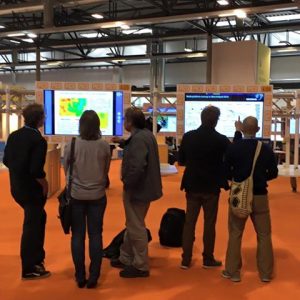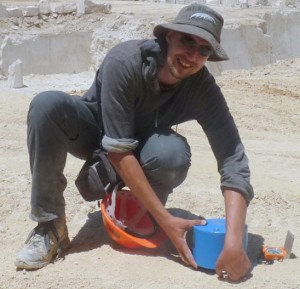EGU’s Pico’s (Presenting Interactive COntent®) are awesome and a lot of fun!! But at this year’s EGU General Assembly there was no Seismology PICO lead session. How sad was this? Why would this be? Can we do anything to change this?
 But wait, how much do you actually know on presenting or preparing a PICO…? Right, just what we thought… Perhaps not that much. There are many benefits to choose for a PICO presentation. Let’s hear out from those who have presented one at EGU. Learn from their experience and maybe you’ll be encouraged to convene a PICO session or submit a PICO abstract in 2017!
But wait, how much do you actually know on presenting or preparing a PICO…? Right, just what we thought… Perhaps not that much. There are many benefits to choose for a PICO presentation. Let’s hear out from those who have presented one at EGU. Learn from their experience and maybe you’ll be encouraged to convene a PICO session or submit a PICO abstract in 2017!
At the EGU we had the opportunity to speak with Simon Virgo, a postdoc at the RWTH Aachen (Germany), and Kathrin Spieker, member of the Seismology ECS Team and a PhD student at the Bergen University (Norway), on their experience how to prepare and present a PICO.
Hi Simon and Kathrin! What were your PICOs about?
Simon: My PICO was “Numerical modelling of crack-seal vein systems with the Discrete Element and Phase-field Method” in TS session “Analogue and numerical modeling of tectonic processes”.
Kathrin: “Mantle dynamics in the Earth and other planetary bodies” in the co-organised session GD3.1/PS9.4/SM6.12.
What are the benefits of having a Pico compared to a Poster/Talk
Simon: The obvious benefit over a poster is that a PICO can contain videos and animated visualisations. I see a great advantage compared to a talk in the possibility of non-linearity: It is possible to prepare a lot of additional slides (e.g. to further explain methods or discuss results in a broader context) that can be navigated to. It allows you to adjust to the current audience: are they familiar with the methods? Yes? Then go directly to the results to enable very specific discussions. A well structured non-linear pico is also more appealing to explore in the times where the pico is not attended by the author.
A lot of discussions were often not discussions between the author and other people but involved much more people that were experts on that specific subject. This is a major advantage over both posters and talks: PICO’s are organized in small sessions attended by scientists of a common peer group. They take time to meet and talk unlike in the huge poster halls where people diffuse over the huge amount of posters. A pico is a great way to have all the people you want to have around to discuss your work with – at the same time!
Kathrin: The 2-minutes-madness in the beginning of a PICO presentation is fun! You advertise your PICO, and believe me a lot of people will come afterwards and talk to you.
Kathrin: PICO’s are so interactive and you can put a lot of information in there. I like to stand in front of the PICO’s and push the buttons as my inner child is all the time excited if a PICO is well made. You can include a lot of figures and movies.
What are the disadvantages of having a Pico ?
Kathrin: It is much more work than preparing a poster or a talk especially if you do it for the first time. I will be much quicker next year. A lot of people come to your PICO. Sure, this is nice, because you can see that many scientist are interested in your work, but you are very busy. Take a bottle of water with you so your mouth doesn’t dry out too much – you really talk a lot!
Simon: Compared to a talk that can reach > 100 people, PICO is limited to maybe 20 people. It is not really a disadvantage but a pico and a talk do not scale in the same way. A disadvantage is that you are really busy during the attendance time so you do not have the opportunity to discuss other picos at the session. Since these are actually the contributions that are often the most interesting for you, this is a real drawback compared to talks.
During a usual day of EGU you can see a lot of people walking around the poster halls when poster sessions have not yet started. This is not (or to a much smaller degree) the case with PICO’s. Out of the attendance time PICO’s do not advertise themselves very well, you have to walk to a screen – start to click around to find out whether a pico is interesting or not. With posters you can often tell this at first glance.
Is it possible to bend these disadvantages in a benefit redesigning the Pico ?
Kathrin: Preparing your first PICO can be hard, especially if you haven’t really seen one before. Unfortunately, the EGU web page doesn’t really provide a good guideline how to prepare a PICO, what’s important or what to avoid. It would be a huge benefit for all PICO newbies to have a proper “how to” guideline. This interview is a great start for that.
Simon: Having a PICO slideshow running as a screen saver would animate/attract a lot more of people! Maybe not the entire pico has to be shown in this “screensaver” mode, one or two slices/videos/animations selected by the author are probably sufficient!
If you would design your Pico presentation again, what would you do differently ?
Simon: Start with the preparation on time! 😉
Kathrin: I would definitely start earlier! 😉
Any Final Tips for Pico newbies?
Simon: Remember that a pico is not a talk. Remember that a pico is not a poster. Embrace the non-linear structure of the pico and prepare more slides than you think you need – you never know where a discussion might go.
Kathrin: I like PICO’s that are interactive, where people can just stand in front of the screen and play with movies and gif-figures. PICO’s are self-explanatory and it is great if you can design a PICO that is fun for people to look at!
Kathrin, Simon, thank you both for this interview.
By Koen Van Noten
Koen Van Noten is a structural geologist and a postdoc at the Seismology-Gravimetry division of the Royal Observatory of Belgium. He primarily investigates the influence of site effects on intraplate earthquake (strong) ground motions by means of “Did You Feel It?” macroseismic data and near-surface geophysical techniques such as H/V Spectral Ratio analysis and Electrical Resistivity Tomography. Koen’s role as an ECS representative is to bridge the gap between seismology and other disciplines. You can reach him at koen.vannoten@seismology.be.


Bárbara Ferreira
Koen, Kathrin and Simon: thanks very much for writing about PICO and for encouraging EGU General Assembly participants to embrace this new presentation medium. You give very useful suggestions and tips on this post.
I wanted to follow up on a point Kathrin made: “Preparing your first PICO can be hard, especially if you haven’t really seen one before. Unfortunately, the EGU web page doesn’t really provide a good guideline how to prepare a PICO, what’s important or what to avoid. It would be a huge benefit for all PICO newbies to have a proper “how to” guideline. ”
There is a short description of PICO, as well as an introductory video, on the EGU 2016 General Assembly website: http://www.egu2016.eu/pico.html. However, I realise this may not be what you were after when you mentioned a “good guideline [on] how to prepare a PICO.” So that we can work on that, could you (Kathrin, as well as Simon and Koen – if you’d given a PICO) give us some more details about what kind of content you’d like to see on such a how-to guide to PICO?
Feel free to reach me by email at media[at]egu.eu.
Thanks again for the great post!
Bárbara (EGU Media and Comms Manager)
Koen Van Noten
Thanks Barbara. I had no PICO this year but I’ll try to encourage others to reach out to you for feedback how to construct a ‘how to’ guideline.
Cheers
Laura Klement (Umwelt uni Giessen)
I did a PICO this year and I was feeling a little unsure if I got the concept from the description on the website.
After my Session, I can say that I would definitely do it again, but I wrote down a “lesson learnt” for me for the next time – I can share it with you too!
1) The PICO Talk is Advertisement. Don’t try to explain all your research in the time your were given, just make them want to visit your PICO Screen. Maybe include a “cliff hanger” 😉
2) PICOs can be viewed by anyone and anytime, they should be understandable when you are not there to talk someone through it
3) Have more slides!
4) Do yourself a favor and build in some kind of navigation inside your presentation so you can quickly jump to slides that you will most likely use a lot to explain your research. Think about what slides those are and on which paths you will likely need to jump. Make sure everything is linked correctly.
I had a Navigation bar to jump to the different sections (methods, results etc.) but I would have still needed a little more.
My PICO Session had 5 minute talks and I think that 2 minutes are sufficient to advertise and adding time will rather make you want to explain it all at the spot.
Just one note: The “First Timers’ Guide to the EGU General Assembly” that I found very helpful contained the information that 2 minutes PICOs should be limited to 2 slides, but it seems that this rule was abandoned and that the information is not accurate anymore.
Thank you for the Interview, I know it would have helped me too and it will surely help people in the future!
Laura
Pingback: GeoLog | Try something different – choose a PICO session at EGU 2017!
Pingback: GeoLog | Presenting at the General Assembly 2017: A quick ‘how to’ from the EGU
Pingback: GeoLog | Try something different at EGU 2019– choose a PICO session!
Pingback: GeoLog | Presenting at the General Assembly 2019: A quick ‘how to’ from the EGU - GeoLog